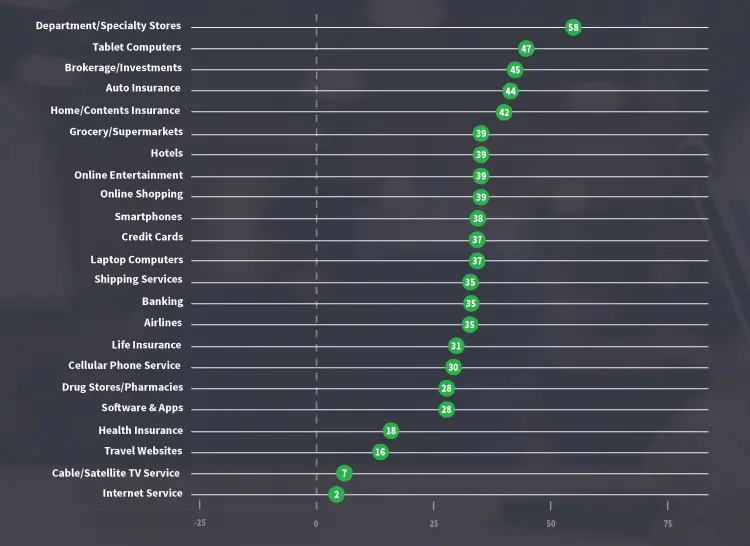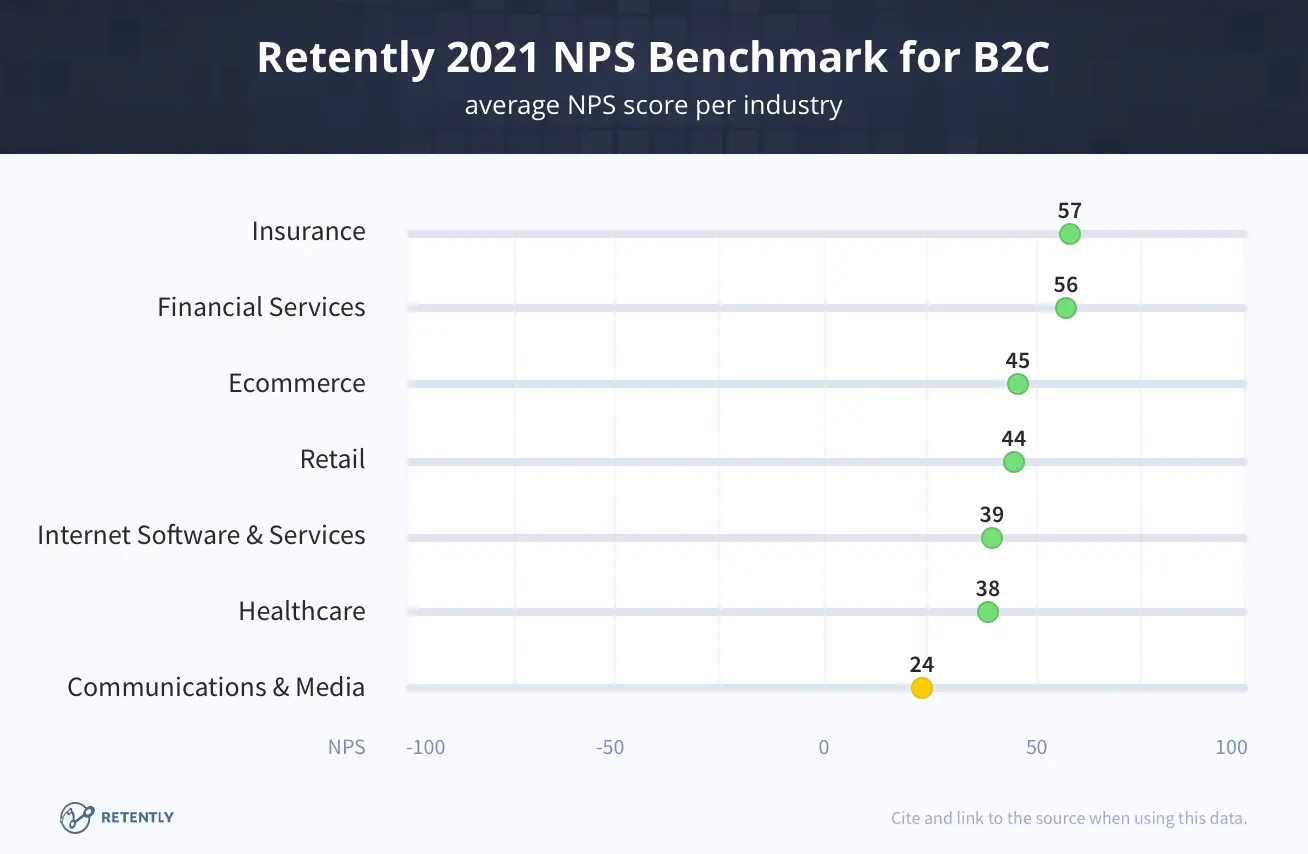Net Promoter Score: The Ultimate Predictor Of Business Growth
How many times have you bought from a company based on a recommendation? Most of us trust the opinion of our friends and family, whose positive experience we will happily follow when deciding whether to use a company. This willingness to recommend a company has shown to be a key measurement of customer satisfaction and loyalty, and in 2003, business analyst Fred Reichheld turned it into a single, easy-to-measure metric: the Net Promoter Score (NPS).
In this article, we’ll delve into the heart of NPS, explore some key reasons why you should be measuring it for your business, and offer some guidance on how to set it up.
Table of contents
- What is a Net Promoter Score?
- Why is your Net Promoter Score important?
- Net Promoter Score calculation
- What is a good Net Promoter Score? How to measure NPS
- How to create a Net Promoter Score
- How to increase your Net Promoter Score
What is a Net Promoter Score
So what is a Net Promoter Score (NPS), exactly? NPS was created by Fred Reichheld and Satmetrix in 2003, as a simple alternative to measuring a customer’s satisfaction with a business, and their loyalty to the brand. It’s a survey that asks one short question:
On a scale of 0-10, how likely are you to recommend [your company name] to your friends, family, or colleagues?
Before NPS was created, companies tried to measure customer satisfaction by sending out bloated surveys that were overwhelming and unlikely to be completed, and difficult to analyse when the results came back. Reichheld’s Net Promoter Score makes customer satisfaction easier to measure by offering just one question, and a grading system that groups customers in three important ways:
- Detractors—customers who are unhappy with your products or services. They are highly unlikely to keep buying from you, are a major churn risk, and depending on where they sit on the scale, might even denounce your company to others. In fact, people are three times more likely to tell others about a bad experience than a good one.3
- Passives—customers who are neither satisfied or dissatisfied with your company. Their behaviour is more difficult to predict—they may buy more of your products or recommend you, or they may not.
- Promoters—evangelists who love your company and will happily recommend you to their friends and family. They’re highly likely to keep purchasing your products and services. Every business wants more of these, as they drive revenue and grow the company. You can also ask your promoters for reviews, testimonials, and case studies, which are invaluable tools for attracting new customers.
Your final NPS score is calculated based on where customers sit on the scale, and ranges from -100 to +100 (we’ll explain this in more detail later).
Why is your Net Promoter Score important?
Why is your Net Promoter Score important? NPS is crucial because it measures customer satisfaction, which translates to brand loyalty. You create loyal customers when your products and services are high quality, when you are meeting your customers’ needs, and when your employees make customers feel like they matter. It’s all about creating a positive, memorable experience for people, which when repeated, wins their devotion and turns them into full-fledged advocates who talk you up to their friends, follow you on social media, and share all of your posts (when they’re not busy buying your products of course).
Loyal customers are a key driver for business growth. They make up just 20% of your audience but a mammoth 80% of your revenue,1 and on average, they spend 67% more on your products and services compared to new customers. They also don’t cost your marketing department anything extra to acquire. Depending on your industry, customer acquisition costs (CAC) can range from around $85 to $1,250 per customer,2 so every time you lose a customer through bad customer service, a flawed product, or a superior competitor, they can cost a lot of money to replace. But when you provide exceptional customer service and create high-quality, long-lasting products, your loyal advocates will refer more customers, who end up having a 16% higher lifetime value4 compared to customers who found your company in other ways. So loyal customers don’t just buy more of your products, they refer customers who spend more money!
Customer loyalty is very important for business growth, which is why NPS is such an important number for a business. The further down the NPS scale you go for individual customers, the greater chance they have of leaving. But loyal customers who sit at 9 and 10 won’t abandon your company. Instead, they drive repeat business, increase your revenue, help you get an edge over your competitors, and when you ask customers to explain their NPS scores, become a treasured source of information on how to improve your business.
NPS can help to educate and motivate your staff too. It gives them a general idea of how satisfied customers are with the company’s efforts, where they might focus their work to improve things, or what should be repeated to create even more loyal evangelists. This can energise team members to do better, especially the ambitious among them.
Net Promoter Score calculation
The Net Promoter Score calculation can be a little confusing, which is why we recommend using software that does everything for you (including the survey itself). But if you’re intent on doing your own Net Promoter Score calculation, here’s how it’s done:
- Put your NPS survey results into a spreadsheet.
- Group the results by detractors (1 to 6), passives (7 and 8), and promoters (9 and 10).
- Add the total number of responses for each group (just the number of responses, not a sum of their scores).
- Divide each group’s total by the total number of survey responses, then multiply by 10 to give you a percentage. For example, if 100 people responded to the survey, and 30 of them are detractors, the calculation would be (100/30)*10 = 33%.
- Subtract the percentage total of detractors from the percentage total of promoters. For example, if 33% are detractors and 50% are promoters, the calculation would be 50-33 = 17. This is your final NPS score.
Again, the easiest way to do a Net Promoter Score calculation is through software, and htere’s
What is a good Net Promoter Score? NICE Satmetrix—the original creators of NPS—suggest that anything over 0 is good, as it means you have more promoters than detractors. Here is their breakdown of “absolute” NPS scores:
- Above 0 is good
- Above 20 is favourable
- Above 50 is excellent
- Above 80 is world-class
But our capitalist economy is competitive, so you really need to know how well you’re doing compared to other companies in your industry, to better understand your relative position. This requires metric benchmarking, which has always been a messy business, requiring time, effort, and original research. Thankfully, some companies understand the awesome power of content marketing, and have happily carried out this research for NPS.
Below you’ll find NPS industry benchmarks from NICE Satmetrix and Retently, which you can use to get a better understanding of how you fare in your industry. You’ll notice that NPS scores vary wildly from industry to industry, so these benchmarks are indispensable to accurately measure customer satisfaction and loyalty.



As with any performance metric, you’ll need to identify trends in your NPS score to see whether customers are becoming more or less loyal. This means that NPS scores should be sent regularly—roughly every quarter to get enough useful, actionable information. If your NPS score has been dropping over the last three quarters, this should motivate you to analyse and fix the issues before they get out of hand. On the flip side, if your NPS score has been steadily increasing, you should try to identify what you’ve been doing right so that you can repeat and improve on it further. You may also want to treat your staff to a night out or weekend away!
When you have enough raw NPS data, you can start to organise and analyse the customer feedback that has been provided. A good method is adding tags to feedback, which helps you to categorise them and identify patterns. For example, if a customer tells you that your products are high quality but slow to arrive after being purchased, you can tag this comment with “product feedback” and “slow shipping,” and then re-use these tags for similar comments. When tallied up, these tags can be turned into a bar chart as a visual demonstration of what your customers think of the business, and what they would like to be improved.
Once you’ve become comfortable with measuring NPS, and are using it to make improvements to your business, you can also start to group your results by customer segments. This makes every score and piece of feedback more refined, allowing you to dig deeper and make more nuanced changes to specific customer groups (also known as market segments).
How to create a Net Promoter Score
The easiest way to create a Net Promoter Score for your business is with software. There’s plenty of tools that automatically send surveys to customers, allow you to add follow-up questions, and calculate the NPS scores for you. HubSpot, AskNicely, Qualtrics, SurveyMonkey, and HotJar are a handful of popular tools, but there’s plenty more out there.
These tools allow you to send the survey to the most effective location for your customers, such as popping up on your website, the admin area of your software, or sent via email after a particular action (e.g. the day after purchasing one of your products). Where and when you send your NPS survey will depend on your type of business, so you’ll need to use your knowledge and experience to figure out what will work best. But whatever you do, don’t try to skew the results to be favourable, like sending out the survey after you announce a price cut for customers. This will just give you biased data, and misses the main point of NPS: to know how satisfied and loyal your customers are, and to identify risks, opportunities, and ways to improve.
The NPS score by itself doesn’t tell you much, so these tools allow you to create follow up questions to gather insights on what to improve. You can even customise your follow-up question based on the user’s score, for example:
- Detractors and passives—what improvements can we make for you to give us a higher rating?
- Promoters—why would you recommend us? What are we doing right?
If you really want to get good information, you can give customers a call to talk about their scores and responses. This can either be done out of the blue, or as a request in the NPS survey itself (e.g. “Are you happy for a 5-minute chat about your response”). Either way, the more information you get from your customers about their potential scores, the better equipped you are to make improvements to your business, and repeat the work that is producing loyal advocates.
How many people to survey? The more the better. As with any type of customer feedback, the more people you have participating, the more accurate your data is likely to be.
How to increase Net Promoter Score
Gold can be found in your customers’ responses about why they gave their NPS score, so your first port of call is to analyse this feedback, share it with your team, and make a plan on how to address it.
Here are some more generic and common ways to increase your NPS score, to make your customers more satisfied and loyal:
- Listen to your customers—ask and ye shall receive. Many of your customers will give you their feedback if you just ask them, or have a candid conversation about how they feel.
- Reach out to customers—when a business offers unprompted help or support, we can’t help but feel appreciated. Being proactive with your support is one of the best ways to get people on your side, and turn passive customers into ardent promoters.
- Support them across various channels—some of us like emailing or messaging, and others prefer having a chat over the phone. Try to offer various support methods to your customers, on as many platforms as possible (including social media).
- Improve your company culture—customer satisfaction suffers in many businesses because some employees resent the customers. Try to build a positive work culture where your staff understand how important every customer is.
By completing these tasks, you should find your Net Promoter Score gradually increasing, and customer loyatly alongside it.
References
- 2019, The Importance of Customer Loyalty – 5 Benefits, Emarsys
- Evan Bailyn, 2020, Average Customer Acquisition Cost (CAC) By Industry: B2B Edition, First Page Sage
- Customer Service Steps Up, Template Lab
- 2013, Referred customers are more profitable and more loyal, Wharton



